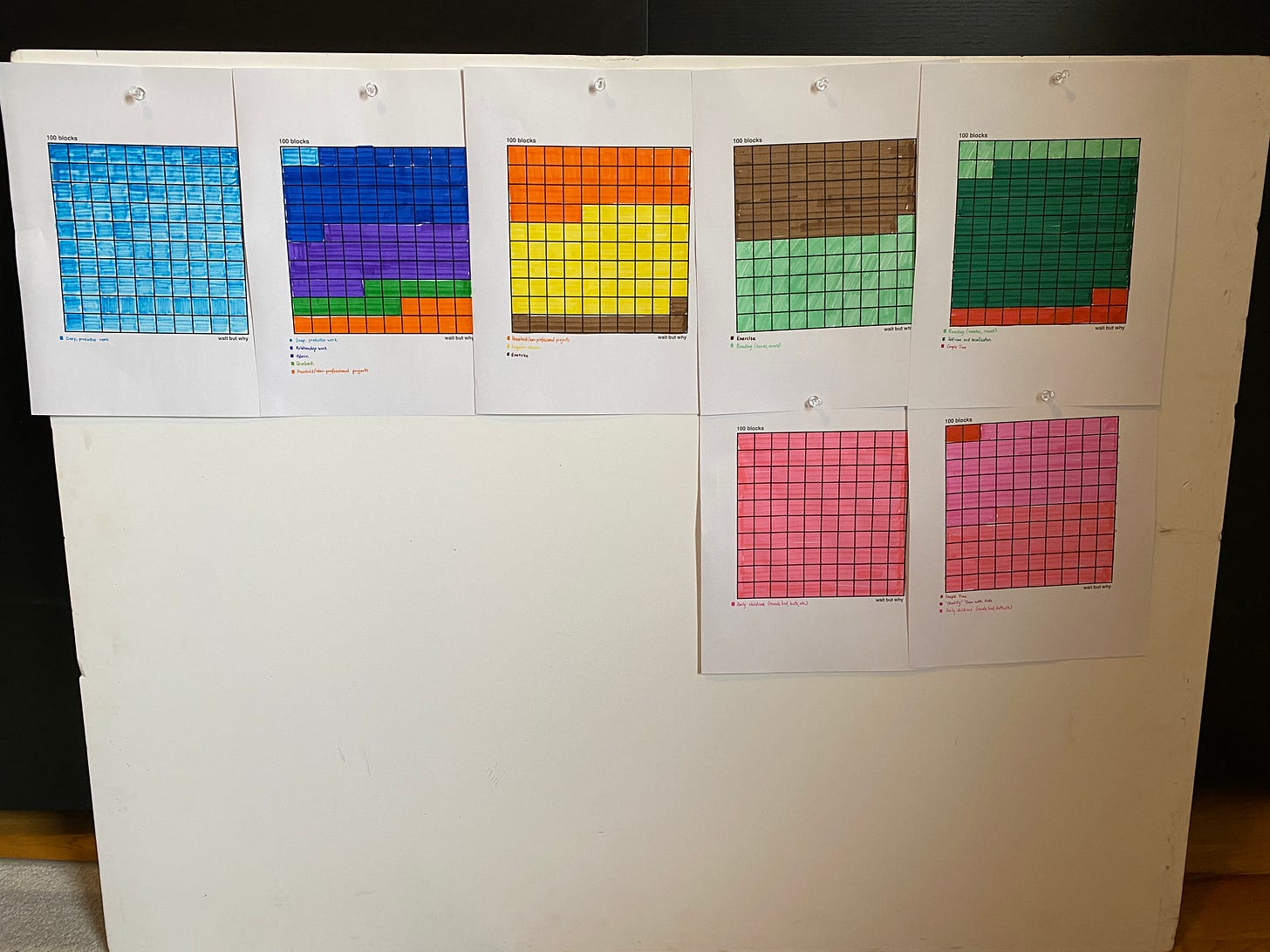I don’t know about you, but I’ve fallen into the bad habit of letting the most important things get short shrift because something urgent comes along, or because my energy is just too depleted for anything besides mindless Twitter scrolling. I was frustrated with myself, and wanted to make more conscious decisions about how I allocated my time. This is a very long and detailed walk through that process.
A few years back, Tim Urban at Wait But Why wrote a post that conceptualized time in ten minute blocks. If you sleep for ~7.5 hours a night, you have about 1000 waking minutes each day, which translates into 100 10-minute blocks to allocate each and every day. Tim writes
It’s always good to step back and think about how we’re using those 100 blocks we get each day. How many of them are put towards making your future better, and how many of them are just there to be enjoyed? How many of them are spent with other people, and how many are for time by yourself? How many are used to create something, and how many are used to consume something? How many of the blocks are focused on your body, how many on your mind, and how many on neither one in particular? Which are your favorite blocks of the day, and which are your least favorite?
Imagine these blocks laid out on a grid. What if you had to label each one with a purpose?
I prefer to think about this at the level of weeks — I have 700 blocks of time each week. How do I ideally want to allocate that time on average? And if I map it out with markers, I get a nice visualization of a week.

My aspirational time allocation
Professional Time
The blue and purple blocks are things that can broadly be described as professional work. Light blue is thoughtful, generative, solitary work (which includes writing this post, as well as reading, taking online courses, and so on). Dark blue is relationship time — meeting with people to discuss projects, exchange ideas, and getting acquainted. Purple is admin work — emails, organizing my to-do list, and generally staying on top of my shit. The lime green squares is time I’ve allocated for professional give-back — whether that’s mentoring a student, giving someone feedback on a project, or contributing to the community.
I’m aiming for the following:
- 3.5 hours each workday on solitary, productive work
- 6.5 hours a week meeting with people
- Just over an hour each workday on admin
- 2 hours a week on give-back.
We’re so inured to busy-ness that ~31 hours a week for professional activities looks like a slacker schedule when it’s written down in black and white. But working about six hours a day doesn’t feel like a slacker schedule when you’re doing it. Indeed, I feel very busy during the workweek, but not exhausted at the end of it. (Imagine that.)
But even with a ~6-hour productive workday, I’m spending way more time on thinking, reading, and writing than I accomplished in a 50-hour work week in a more corporate environment. It’s hard to spend that much time doing deep, productive work. It’s a muscle that requires practice, discipline, and rationing your mental energy appropriately. My deep work discipline is still a work in progress, but I can see how building up that muscle will pay huge dividends.
Personal Time
Yellow is routine chores, like laundry, dishes, grocery shopping, cleaning the house, paying the bills and family paperwork. It’s about an hour a day on dishes and tidying, and then another couple of hours on the less frequent things like vacuuming, bills, or trips to Costco. It’s worth noting that this is only my contribution to the household chores. My husband takes care of 70% of grocery shopping and 99.9% of meal prep, and I think would have more yellow squares than me.
I make the larger contribution in the domain of household projects. Some of these are seasonal (put away the winter hats and mittens, buy Christmas gifts, etc.) Others tend to be things I theoretically would like to do, but in practice always deprioritize. Over the last few years, I’ve wracked up a pretty large ‘household projects’ debt, so I’m deliberately aspiring to a lot of orange squares to catch up on things like organizing junk drawers and assembling family photo albums.
Next up is the stuff-for-me section: exercise (brown), reading (mint green), and rest and relaxation (dark green).
- At 10 hours a week, I’m planning to make time for 10,000 steps a day (about an hour) and two hour-long yoga sessions a week. This is both a lot of exercise to do each week, and about in line with a lot of health recommendations. If work is too much, this is one of the first things that gets squeezed.
- I’ve allocated 90 minutes a day to reading for pleasure. I don’t include reading for work in this category (that falls under the light blue work category and generally involves note taking.) I read the Globe and Mail on dead trees six days a week, and have read six non-work books in the first five weeks of the year.
- I’ve allocated about 12.5 hours a week to R&R. This gives me time to watch a movie or a few episodes of a show, time to visit (virtually) with friends and family, time to nap, time to bake something extravagant. This category is also covering activities like “showering” and “dressing,” which I suppose are comparatively relaxing? Showering and dressing aside, this is another one that gets really pinched when work gets busy.
Family Time
Last but not least is time for the people in my house.
- The smaller block of pink (8.5 hours/week) is “quality” time with my children. These squares are the things you imagine doing when you decide to have children — taking them on outings, reading to them, playing with them. This is probably the time allocation that suffers the most when work becomes too intensive.

- The larger block of pink — 3.5 hours a day, my single largest allocation of time — is all the other aspects of child care. Someone else does the childcare from 8:30–5:30, Monday through Friday, so my time is really just mornings, evenings, and weekends. Dishing up breakfast and supper. Giving baths. Changing diapers. Dressing and undressing. Of course, it’s incorrect to say that none of this is quality time — given that it’s the majority of the time I spend with my children, I really strive to be present and remember that the aggregate of these moments will define our relationship twenty years from now. I go so far as to lock away my phone between 5:30 and 8pm to help with that. But it’s still the case that these are activities that happen on someone else’s say-so (try delaying breakfast with hungry kiddos, I dare you) and that very often feel like a bit of a slog.
- Red is quality, one-on-one time with my husband. I am, on the one hand, pretty shamefaced that he only rates 20 minutes a day. On the other hand, thanks to the pandemic, we are currently in the same room for something approaching 20 hours a day. We watch shows together, walk together some mornings, “visit” friends together, take the kids on outings together, and definitely treat the breakfast/supper/bedtime gauntlet as a team sport. It turns out that a lot of your blocks can go towards two purposes (a phone call while I walk is one of my favourites), and nowhere is that more true than in the time-with-my-husband category.
How my time allocation has changed
As it happens, this is not the first time I have mapped out my model week like this. Around the time Wait But Why published that original post, I was returning from maternity leave with a four-month old at home, and I was inspired to do this exact same exercise. It’s interesting to me to go back to that allocation and compare. Of course, lots of things have changed. I have 100% more children in my house, and they are 5000% more active than a four-month old. We are in the midst of a global pandemic so I am almost always in my house. Anyway, I graphed the differences (and keep in mind that, then as now, this is an aspirational allocation, not a record of how I actually spent my time).
Professional Time

Here are some differences I notice on the work side:
- In my previous job, I had way less time for deep, productive work, and spent way more time on admin. I don’t think that’s more time on personal admin, but rather the additional administrative overhead associated with being on a team: more emails, more meetings, and so on.
- Relationship time used to be marginally higher, but the delta is almost entirely from regular one-on-ones with direct reports.
- I used to have a whole separate category dedicated to something I’ve (retrospectively) dubbed “Leadership time.” In 2016, I had a team of about 20, and I spent a lot of time reviewing work and providing feedback, and attending meetings related to their projects (as opposed to my own).
- For obvious reasons, I have no commuting time in 2021, which is a nice chunk of time to get back into every week.
- Less obvious is that flex time block. Back in 2016, I pro-actively allocated about 42 hours a week to my job. But I knew that very often, the work wouldn’t fit into 42 hours and would still need to get done. The flex time basically covered me up to a 50-hour week (55 including commute). Over 50 hours, and I would be letting work eat into time that was meant to be for other things. If I could keep work hours to more like 42 or 45, I would get a whole extra chunk of time that could go to personal and family time.
- I definitely didn’t dedicate any time to ‘give back’ in 2016. Returning to work with a four-month old was overwhelming, so part of the exercise was dropping anything that felt drop-able.
Personal and Family Time

- You can see household projects, exercise, and reading are all way up in 2021 compared to the 2016 baseline. That’s all a conscious choice of how to allocate time.
- The biggest difference on the personal graph is how much more time is going against childcare in 2021. I think this is all about the age of the kid(s). When I allocated time in 2016, I had a four-month old. At that age, babies sleep a lot, and on weekends, I would have an extra ~4 hours a day while the baby napped, which is pretty much exactly the difference you see on the graph. People talk a lot about how hard newborns and infants are, and it’s certainly true that they make it very difficult to hew to a standard adult sleep cycle/work schedule. But they also sleep a lot, and stay where you put them. I certainly find that in these preschool years, I have been devoting more and more time to childcare (and chores) as the kids have gotten older, because they are awake more, doing more, and demanding more. That wasn’t necessarily what I was expecting ahead of time.
- The chores are also a bit higher. Two active preschoolers make a lot more mess than a single baby, so that makes sense.
So What?
For me, this exercise really viscerally underscores how having small children fundamentally shifts the whole time architecture. Before I had children, I would think nothing of working 60+ hours in a week. And it’s easy to see why…it would still leave me with 3000+ minutes of unallocated time to do as I pleased. And I had more flexibility overall. It was much easier to stay late at work than to wrangle children through supper, bath, and bed and then re-start work at 8:30pm. I could decide to get up early and power through work, whereas now I regularly experience the unmatched frustration of waking up at 5:30am to tackle some work, only to have my 2-year old wake at 5:37.
Parenting small children is relentless. Their schedule is fixed and takes precedence, and options for ‘making’ more time are limited. I can choose to give short shrift to ‘quality time’ with my kids and at some level I choose other activities over my children all the time. But I certainly don’t feel good about my choices if I’m not consistently coming close to the quality time allocation I’ve set out. I can also abdicate childcare time to my husband, but that means I’m taking away his too-scant down time. Otherwise, I’m left with neglecting chores and living in squalour, skipping exercise, or further reducing slim downtime (which, remember, includes stuff like showering….).
Basically, as a parent with small children, life feels unabating when you are working ~45 hour a week. If you’re up over 50 hours, life stops being manageable. You can do it (I have done it), but you are making unattractive compromises and trade-offs that didn’t exist before you were a parent. The only really sustainable solution is to structure work so that parents can work less than 40 hours and still earn enough to pay for housing and childcare.
